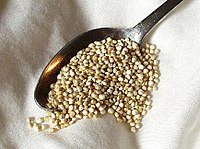Pseudocereal
(Redirected from Pseudocereals)
This article needs additional citations for verification. (August 2010) |
A pseudocereal or pseudograin is one of any non-grasses that are used in much the same way as cereals (true cereals are grasses). Pseudocereals can be further distinguished from other non-cereal staple crops (such as potatoes) by their being processed like a cereal: their seed can be ground into flour and otherwise used as a cereal. Prominent examples of pseudocereals include amaranth (love-lies-bleeding, red amaranth, Prince-of-Wales-feather), quinoa, and buckwheat.[1]
Common pseudocereals
- Acorn
- Amaranth (Love-lies-bleeding, Red amaranth, Prince-of-Wales-feather)
- Breadnut
- Buckwheat
- Cañahua
- Chia
- Cockscomb (also called quail grass or soko)
- Pitseed goosefoot
- Quinoa
- Wattleseed (also called acacia seed)
Production
The following table shows the annual production of some pseudocereals in 1961,[2] 2010, 2011, 2012, and 2013 ranked by 2013 production.[3]
| Grain | Worldwide production (millions of metric tons) |
Notes | ||||
|---|---|---|---|---|---|---|
| 1961 | 2010 | 2011 | 2012 | 2013 | ||
| Buckwheat | 2.5 | 1.4 | 2.3 | 2.3 | 2.5 | A pseudocereal in the family Polygonaceae that is used extensively in India during fasts, and in Eurasia and to a minor degree the United States and Brazil. Major uses include various pancakes, groats, and noodle production. |
| Quinoa | 0.03 | 0.08 | 0.08 | 0.08 | 0.10 | A pseudocereal in the family Amaranthaceae, traditional to the Andes, but increasingly popular elsewhere. |
Other grains that are locally important, but are not included in FAO statistics, include:
- Amaranth, an ancient pseudocereal, formerly a staple crop of the Aztec Empire and now widely grown in Africa.
- Kañiwa or Cañahua, close relative of quinoa.
References
- ^ "Glossary of Agricultural Production, Programs and Policy". University of Arkansas Division of Agriculture. Archived from the original on 2007-02-14. Retrieved 2006-12-31.
- ^ 1961 is the earliest year for which FAO statistics are available.
- ^ "ProdSTAT". FAOSTAT. Retrieved 26 December 2006.
